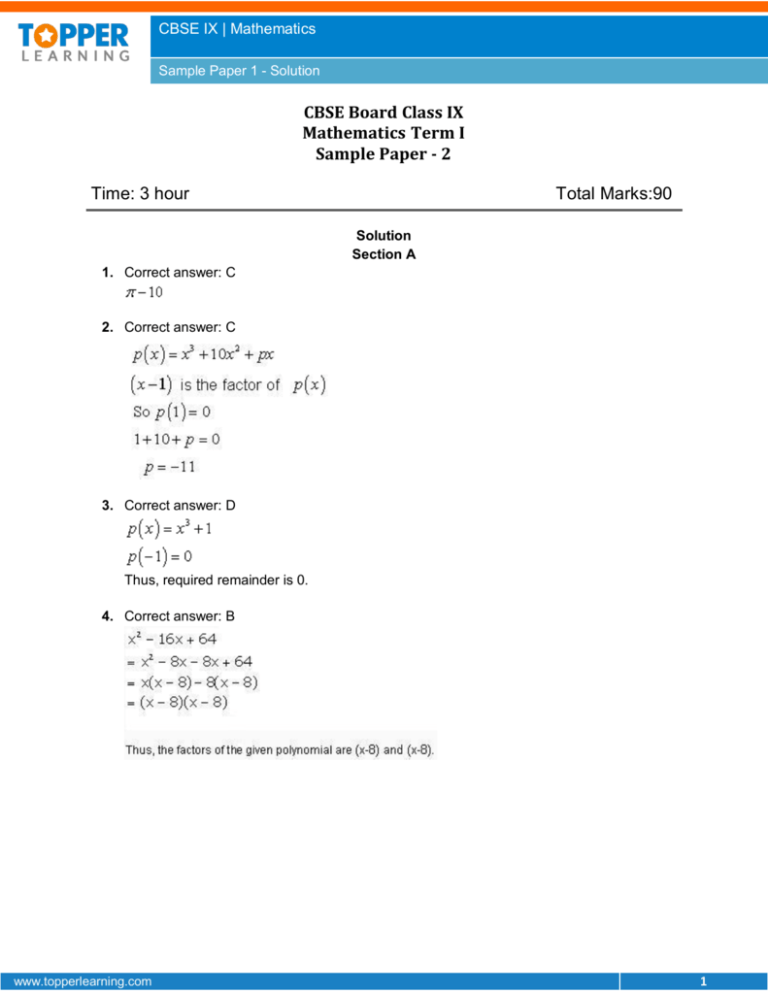File
advertisement

CBSE IX | Mathematics Sample Paper 1 - Solution CBSE Board Class IX Mathematics Term I Sample Paper - 2 Total Marks:90 Time: 3 hour 90 Solution Section A 1. Correct answer: C 2. Correct answer: C 3. Correct answer: D Thus, required remainder is 0. 4. Correct answer: B www.topperlearning.com 1 CBSE IX | Mathematics Sample Paper 1 - Solution 5. Correct answer: B We know corresponding angles are equal. So, 1 = 2 = 40o Therefore, x = 180o - 40o = 140o 6. Correct answer: B Two triangles will be congruent by SAS axiom if 2 sides and the included angle of one triangle are equal to the two sides and the included angle of the other triangle.Thus, the triangles will be congruent when AC=DE. 7. Correct answer: A 8. Correct answer: A www.topperlearning.com 2 CBSE IX | Mathematics Sample Paper 1 - Solution Section B 9. = = = 10. 11. Let x = 75, y = -25, z = -50 x + y + z = 75 - 25 - 50 = 0 We know, if x + y + z = 0 then x3 + y3 + z3 = 3xyz 753 - 253 - 503 = 3(75) (-25) (-50) = 281250 www.topperlearning.com 3 CBSE IX | Mathematics Sample Paper 1 - Solution 12. OR 13. AD is the bisector of A BAD = CAD Exterior BDA > CAD BDA > BAD AB > BD (side opposite the bigger angle is longer) 14. www.topperlearning.com 4 CBSE IX | Mathematics Sample Paper 1 - Solution Section C 15. www.topperlearning.com 5 CBSE IX | Mathematics Sample Paper 1 - Solution 16. Using Pythagoras theorem: 5 = 22 + 12 Taking positive square root, we get, 5 (2)2 (1)2 (i) We mark a point 'A' representing 2 units on number line. (ii) Construct AB of unit length perpendicular to OA. Then, join OB. (iii) Taking O as centre and OB as radius, draw an arc intersecting number line at point C. (iv) Point C represents 5 on number line. 17. OR www.topperlearning.com 6 CBSE IX | Mathematics Sample Paper 1 - Solution 18. www.topperlearning.com 7 CBSE IX | Mathematics Sample Paper 1 - Solution 19. www.topperlearning.com 8 CBSE IX | Mathematics Sample Paper 1 - Solution 20. OR www.topperlearning.com 9 CBSE IX | Mathematics Sample Paper 1 - Solution 21. In ABD and ACE ADB= AEC= 900 BAD= CAE (common angle) BD = CE (given) By AAS Criteria ABD ACE AB = AC (CPCT) Hence, ABC is isosceles. 22. In AOD and AD = AB AO =AO OD = OB AOD AOD = AOB (given) (common side) (given) AOB AOB (SSS congruence rule) (c.p.c.t) Similarly, DOC BOC (SSS congruence rule) DOC = BOC (c.p.c.t) AOD + AOB + DOC + BOC = 360o (angles at a point) o 2 AOD + 2 DOC = 360 AOD + DOC = 180o Hence, AO and OC are in one and the same straight line. www.topperlearning.com 10 CBSE IX | Mathematics Sample Paper 1 - Solution 23. OR www.topperlearning.com 11 CBSE IX | Mathematics Sample Paper 1 - Solution 24. Let ABCD be the garden. Area of the garden = 180 + 126 = 306 m2 www.topperlearning.com 12 CBSE IX | Mathematics Sample Paper 1 - Solution Section D 25. OR www.topperlearning.com 13 CBSE IX | Mathematics Sample Paper 1 - Solution 26. 27. Let f(x) = x3 + 2x2 -5ax -8 and g(x) = x3 + ax2 -12x -6 When divided by (x-2) and (x-3),f(x) and g(x) leave remainder p and q respectively g(x) = x3 + ax2 -12x -6 www.topperlearning.com 14 CBSE IX | Mathematics Sample Paper 1 - Solution 28. 29. Let p(x) = x3 + 13x2 + 32x + 20 p(-1) = -1 + 13 - 32 + 20 = -33 + 33 = 0 Therefore (x + 1) is a factor of p(x). On dividing p(x) by (x + 1) we get p(x) ÷ (x + 1) = x2 + 12x + 20 Thus, x3 + 13x2 + 32x + 20 = (x + 1)(x2 + 12x + 20) = (x + 1) (x2 + 10x + 2x + 20) = (x + 1)[x(x + 10) + 2(x + 10)] = (x + 1) (x +2) (x + 10) Hence, x3 + 13x2 + 32x + 20 = (x + 1) (x +2) (x + 10). OR Given: 8x3 + 27y3 = 730 2x2y + 3xy2 = 15 Now, (2x + 3y)3 = (2x)3 + (3y)3 + 3 (2x) (3y) (2x + 3y) = 8x3 + 27y3 + 18xy (2x + 3y) So, (2x + 3y)3 = 8x3 + 27y3 + 18 (2x2y + 3xy2) (2x + 3y)3 = 730 + 18 (15) [Using the given conditions] = 730 + 270 (2x + 3y)3 = 1000 Therefore, 2x + 3y = 10 www.topperlearning.com 15 CBSE IX | Mathematics Sample Paper 1 - Solution 30. Euclid's 5th postulate states that: If a straight line falling on two straight lines makes the interior angles on the same side of it taken together less than two right angles, then the two straight lines, if produced indefinitely, meet on that side on which the sum of angles is less than two right angles. This implies that if n intersects lines l and m and if meet in the side of 1 and . In that case, producing line l and mfurther will 2 which is less than 180o If In that case, the lines l and m neither meet at the side of 1 and 2 nor at the side of 3 and 4 implying that the lines l and m will never intersect each other.Therefore, the lines are parallel. 31. Given that Now in … (i) DBC and EAC [from (i)] BC = AC (Given) (Given) (ASA Congruence) Therefore, BD =AE (CPCT) www.topperlearning.com 16 CBSE IX | Mathematics Sample Paper 1 - Solution 32. Given: l||m To prove: 1 + 2 - 3 = 180o Construction: Draw XC||AB and extend AB to Y. Proof: BCX = 180o - 1 (sum of int. s on same side of transversal is 180 o) XCD = 3 (Alternate int. s) Now, 2 = BCX + XCD Or, 2 = (180o - 1) + 3 1 + 2 - 3 = 180o 33. Given: AC = AE, AB = AD and BAD = To prove: BC = DE Proof: BAD = EAC (given) BAD + DAC = EAC + DAC BAC = DAE Now ABC and ADE www.topperlearning.com EAC 17 CBSE IX | Mathematics Sample Paper 1 - Solution 34. The points (-1,0) (1,0) (1,2) (-1,2) can be plotted on a graph as follows: Shape of the lawn is square. Tree is to be planted at the centre of the lawn, so it must be planted at the point of intersection of its diagonals, i.e., at (0,1). Value indicated: Protection of environment www.topperlearning.com 18




